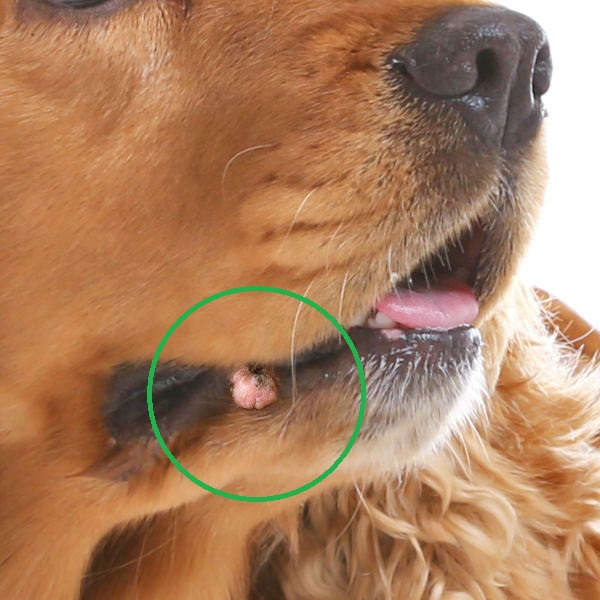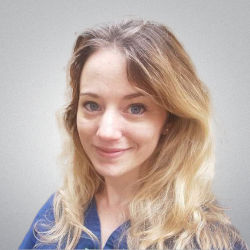
This article was updated on November 17th, 2023
Finding a new white bump or spot on your dog’s lips will always be a cause for concern. In our veterinary clinic, I see at least one dog a day with a new lump that is worrying their owner. This article will explain the top causes of white bumps on a dog’s lips and what actions to take.
Top causes of white bumps on dog lips [with pictures]
1. Oral papilloma (warts)
By far the most common cause of white spots on dogs’ lips is the Papillomavirus. Just like young children commonly get warts on their hands when at school, dogs frequently develop warts on their mouth and lips.

Here is another example below:

You can also view these examples on the web: Example 1, Example 2.
A dog becomes infected when sniffing and licking the face of another dog with warts. They are usually harmless and resolve without any treatment in one to two months. Some dogs only get one or two, while others will develop quite a few.
Warts can grow on gums, lips and skins. They look fleshy and can often be white or pinkish. Most warts cause no bother but can occasionally bleed or become infected. Click here to view more pictures of warts (papilloma) or learn about treatment options.
2. A tick
Some ticks will be an off-white or grey-white color, and an inexperienced owner may mistake them for a growth. They are smooth and shiny on the surface. When you look closely, you can see their black, spindly legs.

Ticks suck a dog’s blood and grow large and plump over the course of a few days. By about day five, they fall off. For this reason, a growth that has been there for a while will not be a tick. View pictures of ticks on dogs.
3. A pustule
A pustule (an infected, pus-filled blister) may appear white, yellow, or green. We tend to see pustules in dogs who have skin allergies and/or dog acne. In addition to the pustules, we often also see redness or visibly swollen skin. Your dog may also appear to be itchy.

Here is another example picture from the web.
Without treatment, bacterial infections can worsen and spread. For that reason, it is wise to be on the ball when you first see a pustule forming. Treatment generally consists of antibiotics and local washes. If the skin is very inflamed, steroids may be issued as well. Learn more about dog acne and pimples.
4. A skin tag
Older dogs are particularly prone to skin tags. They can be a white-grey or a fleshy pink color. Skin tags can grow anywhere on the body, including near the mouth. They are slow growing and hang loosely from the body.

An older dog who develops one skin tag will usually go on to develop more over the years. They can become quite long and pendulous, but don’t worry—they don’t cause any pain.
View more pictures of skin tags and learn about the differences between skin tags and warts.
5. A cancer
While tumors are typically colored (pink, red, or black), we need to consider that any new lump could be cancerous. Cancers are more likely in an older patient.
“Masses on the lips and around the mouth of a dog should be addressed by your veterinarian right away as the area can be difficult to remove larger tumors from successfully.”
Cancerous growths tend to progress rapidly, and the surface can ulcerate and bleed.
Not seeing what you want?
Read our article about white bumps and lumps on dogs (7 vet-explained causes)
See your vet if the bump is growing, bothering your dog, or not resolving
Our veterinarian Dr. Linda Simon explains:
“When a new lip lump is growing at a rapid rate, bothering your dog, or has not resolved within a couple of weeks, it is time to see the vet.”
Additionally, a vet should be seen right away if you think your dog has a tick but are not comfortable treating it from home. You can also watch this video to find out how to do it yourself.
Is there anything I can try at home to help my dog?
The answer depends on which type of white spot or bump your dog has on their lip. Many white lip spots are nothing to worry about, but it is always best to double-check with a veterinary professional. A vet exam is likely required to confirm what those white spots or bumps are.
- Warts or skin tags: There is no need to try any at-home treatments for warts or skin tags, as they should shrink and resolve with time. If a wart is causing your dog issues, you can consider having a vet remove them (read our article: How to Remove Warts).
- Pustules: If your dog has pustules, consider bathing the skin from home with a Douxo wash. You can also buy wipes that are impregnated with this wash. This helps to reduce the level of yeast and bacteria around the mouth and on the chin.
- Email a picture to your vet: you can always take a picture of your dog’s skin issues and email them to your vet to find out if you should schedule an appointment.
Veterinarian Tip: Ticks should not be manually removed at home by owners as pulling them out often leaves the tick’s mouthparts buried in your dog’s skin. Contact your veterinarian for help.
Visiting your vet about white spots on lips
The vet consult will include a history taking and general physical exam. The vet will then focus on the new growth, visually inspecting it and palpating it.
Diagnosis
In some cases, a vet will know what a new white bump or spot is, just from looking at it. At other times, a biopsy would have to be taken, so we can know for sure what we are dealing with.
Treatments
If a dog is diagnosed with a white wart or skin tag, these are generally left well alone. Warts should resolve over time, while skin tags should continue to grow very slowly, not troubling the pet.
Infections will need treatment, and this usually includes topical and/or oral antibiotics.
If a cancer is diagnosed, the sooner this can be surgically removed the better. When the lips and mouth are affected, the surgery is sometimes performed by a specialist, especially if the tumour is large.
Cost estimates
The cost to have a vet check over any warts or skin tags, should just be the cost of the consult and examination: about $50-100. Any needed diagnostics, such as sampling the mass, will add to the cost (An FNA or biopsy might be another $50-$200).
If a cancer is discovered and surgery is required to remove it, costs vary greatly depending on the patient as well as on the type and size of growth. As a rough guide, lump removal is from $300-1,000.
Related post: Dog with Red & Swollen Lips
Disclaimer: This website's content is not a substitute for veterinary care. Always consult with your veterinarian for healthcare decisions. Read More.




Be the first to comment